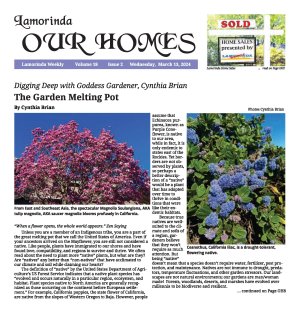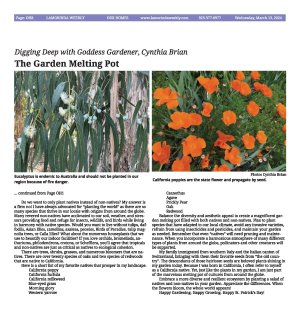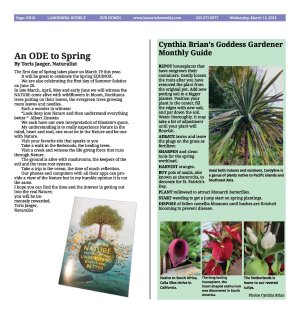|
|
Published March 13th, 2024
|
Digging Deep with Goddess Gardener, Cynthia Brian
|
| The Garden Melting Pot |
| By Cynthia Brian |
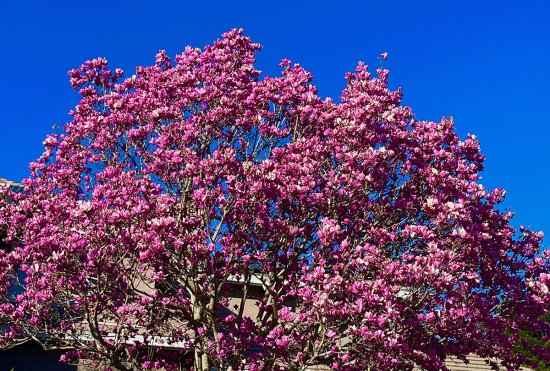 |
| From East and Southeast Asia, the spectacular Magnolia Soulangiana, AKA tulip magnolia, AKA saucer magnolia blooms profusely in California. Photos Cynthia Brian |
"When a flower opens, the whole world appears." Zen Saying
 Unless you are a member of an Indigenous tribe, you are a part of the great melting pot that we call the United States of America. Even if your ancestors arrived on the Mayflower, you are still not considered a native. Like people, plants have immigrated to our shores and have found love, compatibility, and regions to survive and thrive. We often read about the need to plant more
"natives" plants, but what are they? Are "natives" any better than "non-natives" that have acclimated to our climate and soil while claiming our hearts?
Unless you are a member of an Indigenous tribe, you are a part of the great melting pot that we call the United States of America. Even if your ancestors arrived on the Mayflower, you are still not considered a native. Like people, plants have immigrated to our shores and have found love, compatibility, and regions to survive and thrive. We often read about the need to plant more
"natives" plants, but what are they? Are "natives" any better than "non-natives" that have acclimated to our climate and soil while claiming our hearts?
 The definition of "natives" by the United States Department of Agriculture's US Forest Service indicates that a native plant species has
"evolved and occurs naturally in a particular region, ecosystem, and habitat. Plant species native to North America are generally recognized as those occurring on the continent before European settlement." For example, California poppies, the state flower of California, are native from the slopes of Western Oregon to Baja. However, people assume that Echinacea purpurea, known as Purple Coneflower, is native to our area, while in fact, it is only endemic to states east of the Rockies. Yet borders are not observed by plants, so perhaps a better description of a
"natives" would be a plant that has adapted over time to thrive in conditions that were like their endemic habitats.
The definition of "natives" by the United States Department of Agriculture's US Forest Service indicates that a native plant species has
"evolved and occurs naturally in a particular region, ecosystem, and habitat. Plant species native to North America are generally recognized as those occurring on the continent before European settlement." For example, California poppies, the state flower of California, are native from the slopes of Western Oregon to Baja. However, people assume that Echinacea purpurea, known as Purple Coneflower, is native to our area, while in fact, it is only endemic to states east of the Rockies. Yet borders are not observed by plants, so perhaps a better description of a
"natives" would be a plant that has adapted over time to thrive in conditions that were like their endemic habitats.
 Because true"natives"are well-suited to the climate and soils of a region, gardeners believe that they won't require as much attention. But being
"natives" doesn't mean that a species doesn't require water, fertilizer, pest protection, and maintenance."natives"are not immune to drought, predators, temperature fluctuations, and other garden stressors. Our landscapes are not natural environments; our gardens are man/woman made! Forests, woodlands, deserts, and marshes have evolved over millennia to be biodiverse and resilient.
Because true"natives"are well-suited to the climate and soils of a region, gardeners believe that they won't require as much attention. But being
"natives" doesn't mean that a species doesn't require water, fertilizer, pest protection, and maintenance."natives"are not immune to drought, predators, temperature fluctuations, and other garden stressors. Our landscapes are not natural environments; our gardens are man/woman made! Forests, woodlands, deserts, and marshes have evolved over millennia to be biodiverse and resilient.
 Do we want to only plant"natives"instead of non-natives? My answer is a firm no! I have always advocated for
"planting the world" as there are so many species that thrive in our locale with origins from around the globe. Many revered non-natives have acclimated to our soil, weather, and stressors providing food and refuge for insects, wildlife, and birds while living in harmony with native species. Would you want to live without tulips, daffodils, Asian lilies, camellias, azaleas, peonies, Birds of Paradise, tulip magnolia trees, or Calla lilies? What about the numerous houseplants that we use to beautify our indoor facilities? If you love orchids, bromeliads, anthuriums, philodendrons, crotons, or Schefflera, you'll agree that tropicals and non-natives are just as critical as"natives"to ecological cohesion.
Do we want to only plant"natives"instead of non-natives? My answer is a firm no! I have always advocated for
"planting the world" as there are so many species that thrive in our locale with origins from around the globe. Many revered non-natives have acclimated to our soil, weather, and stressors providing food and refuge for insects, wildlife, and birds while living in harmony with native species. Would you want to live without tulips, daffodils, Asian lilies, camellias, azaleas, peonies, Birds of Paradise, tulip magnolia trees, or Calla lilies? What about the numerous houseplants that we use to beautify our indoor facilities? If you love orchids, bromeliads, anthuriums, philodendrons, crotons, or Schefflera, you'll agree that tropicals and non-natives are just as critical as"natives"to ecological cohesion.
 There are trees, shrubs, grasses, and numerous bloomers that are natives. There are over twenty species of oaks and two species of redwoods that are native to California.
There are trees, shrubs, grasses, and numerous bloomers that are natives. There are over twenty species of oaks and two species of redwoods that are native to California.
 Here is a short list of my favorite"natives"that prosper in my landscape.
Here is a short list of my favorite"natives"that prosper in my landscape.
 California poppy
California poppy
 California fuchsia
California fuchsia
 California milkweed
California milkweed
 Blue-eyed grass
Blue-eyed grass
 Morning glory
Morning glory
 Western yarrow
Western yarrow
 Ceanothus
Ceanothus
 Agave
Agave
 Prickly Pear
Prickly Pear
 Oak
Oak
 Redwood
Redwood
 Balance the diversity and aesthetic appeal to create a magnificent garden melting pot filled with both"natives"and non-natives. Plan to plant species that have adapted to our local climate, avoid any invasive varieties, refrain from using insecticides and pesticides, and maintain your garden as needed. Remember that even
"natives" will need pruning and maintenance. When you incorporate a harmonious atmosphere of many different types of plants from around the globe, pollinators and other creatures will be supported.
Balance the diversity and aesthetic appeal to create a magnificent garden melting pot filled with both"natives"and non-natives. Plan to plant species that have adapted to our local climate, avoid any invasive varieties, refrain from using insecticides and pesticides, and maintain your garden as needed. Remember that even
"natives" will need pruning and maintenance. When you incorporate a harmonious atmosphere of many different types of plants from around the globe, pollinators and other creatures will be supported.
 My family immigrated from southern Italy and the Italian canton of Switzerland, bringing with them their favorite seeds from
"the old country". The descendants of those heirloom seeds are beloved plants shining in my garden today. Because I was born in California, I often refer to myself as a California native. Yet, just like the plants in my garden, I am just part of the marvelous melting pot of cultures from around the globe.
My family immigrated from southern Italy and the Italian canton of Switzerland, bringing with them their favorite seeds from
"the old country". The descendants of those heirloom seeds are beloved plants shining in my garden today. Because I was born in California, I often refer to myself as a California native. Yet, just like the plants in my garden, I am just part of the marvelous melting pot of cultures from around the globe.
 Embrace a more diverse and resilient ecosystem by planting a salad of"natives"and non-natives in your garden. Appreciate the differences. When the flowers bloom, the whole world appears!
Embrace a more diverse and resilient ecosystem by planting a salad of"natives"and non-natives in your garden. Appreciate the differences. When the flowers bloom, the whole world appears!
 Happy Gardening. Happy Growing. Happy St. Patrick's Day!
Happy Gardening. Happy Growing. Happy St. Patrick's Day!
 Cynthia Brian's Goddess Gardener Monthly Guide
Cynthia Brian's Goddess Gardener Monthly Guide

 REPOT houseplants that have outgrown their containers. Gently loosen the roots after you have removed the plant from the original pot. Add new potting soil to a bigger planter. Position your plant in the center, fill the edges with new soil, and pat down the soil. Water thoroughly. It may take a bit of adjustment until your plant will flourish.
REPOT houseplants that have outgrown their containers. Gently loosen the roots after you have removed the plant from the original pot. Add new potting soil to a bigger planter. Position your plant in the center, fill the edges with new soil, and pat down the soil. Water thoroughly. It may take a bit of adjustment until your plant will flourish.
 AERATE lawns and leave the plugs on the grass as fertilizer.
AERATE lawns and leave the plugs on the grass as fertilizer.
 SHARPEN and clean tools for the spring workload.
SHARPEN and clean tools for the spring workload.
 HARVEST oranges.
HARVEST oranges.
 BUY pots of oxalis, also known as shamrocks, to decorate for St. Patrick's Day.
BUY pots of oxalis, also known as shamrocks, to decorate for St. Patrick's Day.
 PLANT milkweed to attract Monarch butterflies.
PLANT milkweed to attract Monarch butterflies.
 START weeding to get a jump start on spring plantings.
START weeding to get a jump start on spring plantings.
 DISPOSE of fallen camellia blossoms until bushes are finished blooming to prevent disease.
DISPOSE of fallen camellia blossoms until bushes are finished blooming to prevent disease. |
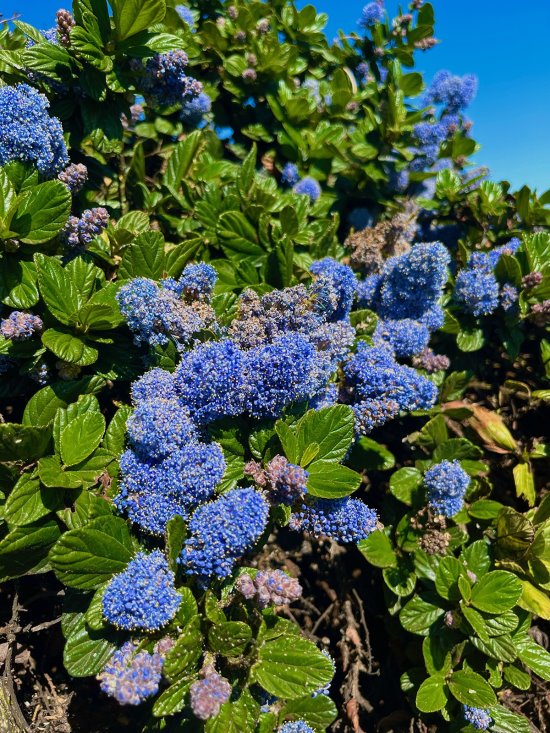 |
| Ceanothus, California lilac, is a drought-tolerant, flowering native. Photos Cynthia Brian |
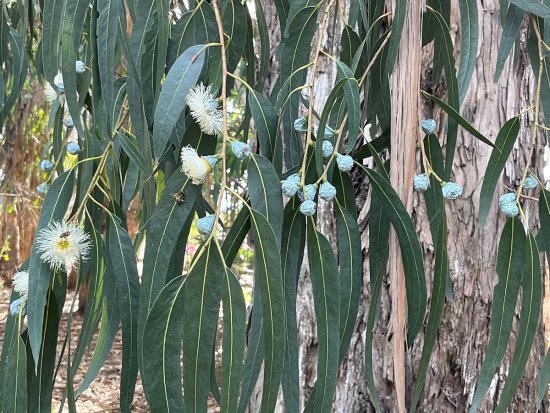 |
| Eucalyptus is endemic to Australia and should not be planted in our region because of fire danger. Photos Cynthia Brian |
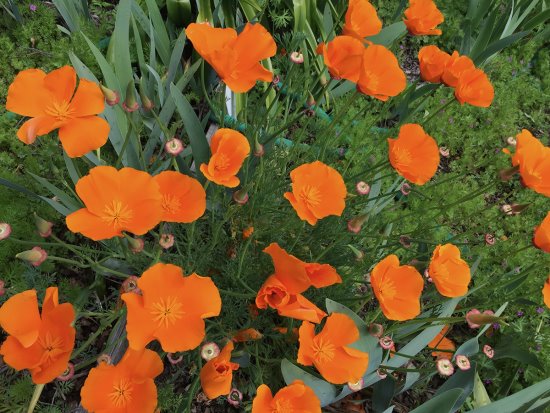 |
| California poppies are the state flower and propagate by seed. Photos Cynthia Brian |
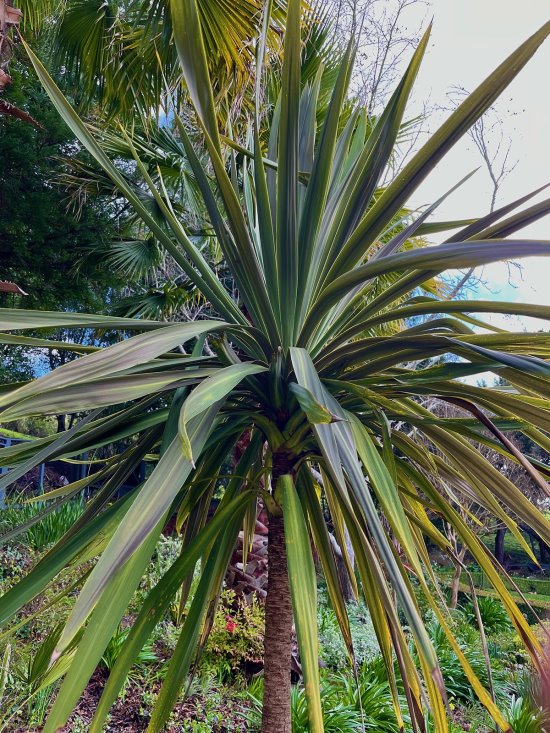 |
| Used both indoors and outdoors, Cordyline is a genus of plants native to Pacific islands and Southeast Asia. Photos Cynthia Brian |
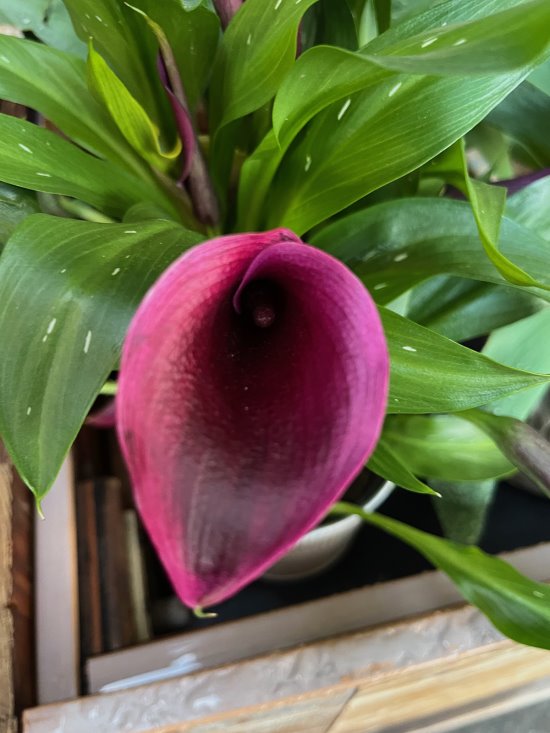 |
| Native to South Africa, Calla lilies thrive in California. |
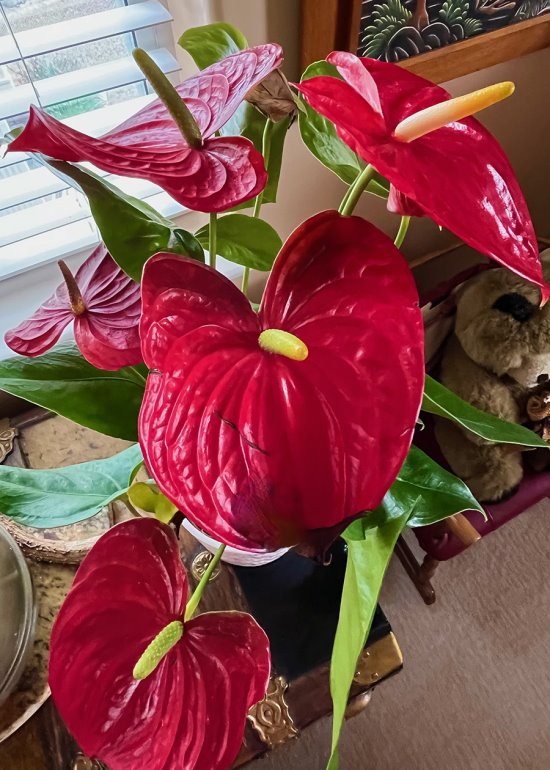 |
| The long-lasting houseplant, the heart-shaped anthurium was
discovered in South America. |
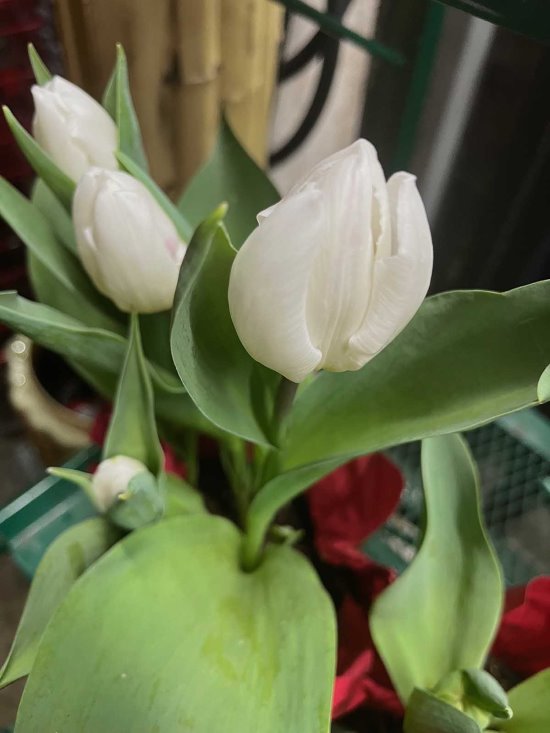 |
| The Netherlands is home to our revered tulips. |
 |
Getting ready for spring, Cynthia Brian rejuvenates at the ocean.
For more gardening advice for all seasons, check out Growing with the Goddess Gardener at
https://www.CynthiaBrian.com/books. Raised in the vineyards of Napa County, Cynthia Brian is a New York Times best-selling author, actor, radio personality, speaker, media and writing coach as well as the Founder and Executive Director of Be the Star You Are! 501 c3. Tune into Cynthia's StarStyle Radio Broadcast at
www.StarStyleRadio.com. Her newest children's picture book, Family Forever, from the series, Stella Bella's Barnyard Adventures is available now at
https://www.CynthiaBrian.com/online-store. Hire Cynthia for writing projects, garden consults, and inspirational lectures.
Cynthia@GoddessGardener.com
https://www.CynthiaBrian.com
|
|
|
|










